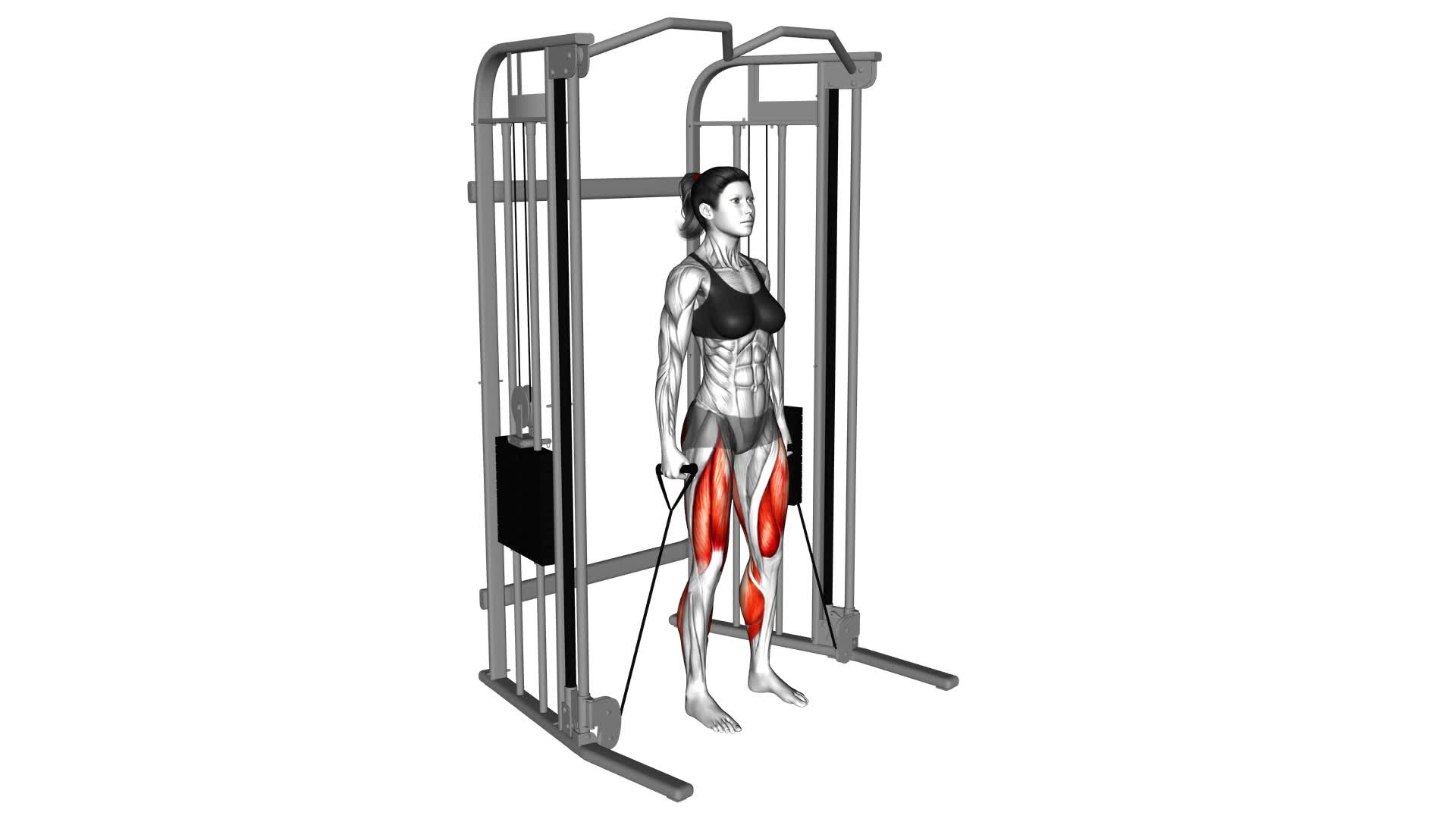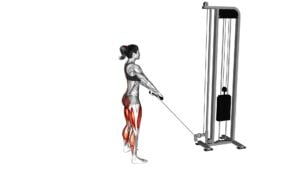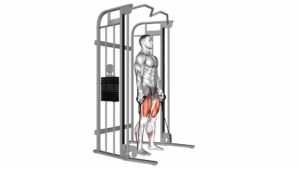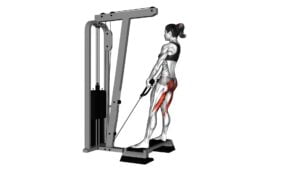Cable Deadlift (female) – Video Exercise Guide & Tips

Are you looking to strengthen and tone your lower body? Look no further than the cable deadlift!
Watch This Exercise Video
This exercise is perfect for women who want to target their glutes, hamstrings, and quads.
In this video exercise guide, you'll learn the proper form and technique for the cable deadlift, as well as variations and modifications to suit your fitness level.
Avoid common mistakes and maximize the effectiveness of this exercise to achieve your fitness goals.
Let's get started!
Key Takeaways
- Cable deadlifts can increase stability and control with the cable machine.
- Cable deadlifts effectively target the glutes, hamstrings, and quads.
- Cable deadlifts can improve strength and muscle development in the posterior chain muscles.
- Cable deadlifts enhance grip strength and can be adjusted to different fitness levels.
Benefits of Cable Deadlift for Women
You can experience several benefits from incorporating cable deadlifts into your workout routine as a woman. Cable deadlifts offer a variety of advantages compared to other exercises, such as barbell deadlifts or cable deadlift alternatives. One major benefit is the increased stability and control that the cable machine provides. Unlike barbell deadlifts, where the weight is fixed and can be challenging to balance, cable deadlifts allow you to adjust the weight and resistance according to your fitness level. This makes it easier to maintain proper form and technique throughout the exercise.
Another advantage of cable deadlifts is the added focus on the posterior chain muscles, including the glutes, hamstrings, and lower back. By using cables instead of a barbell, you can target these muscles more effectively, leading to improved strength and muscle development. Additionally, cable deadlifts can help improve your grip strength, as you have to hold onto the cable handles throughout the movement.
Proper Form and Technique for Cable Deadlift
To perform cable deadlifts with proper form and technique, it's important to follow these guidelines.
Cable deadlifts offer various benefits, such as targeting multiple muscles and improving overall strength.
To begin, adjust the cable machine so that the pulley is at the lowest setting and attach a straight bar or rope handle.
Stand facing the machine with your feet shoulder-width apart and your knees slightly bent. Engage your core and maintain a neutral spine throughout the exercise.
Grasp the bar or handles with an overhand grip, keeping your arms fully extended.
As you exhale, push through your heels and extend your hips forward, pulling the cable upwards. Keep your back straight and avoid rounding your shoulders.
Pause for a moment at the top of the movement and squeeze your glutes.
Slowly lower the cable back down, maintaining control.
You can also try different cable deadlift variations, such as single-leg cable deadlifts or sumo cable deadlifts, to target different muscles and add variety to your workout routine.
Remember to start with lighter weights and gradually increase the load as you improve your form and strength.
Variations and Modifications of Cable Deadlift for Females
Cable deadlifts for females can be modified and varied to target specific muscles and add diversity to your workout routine. By making variations and modifications to the cable deadlift exercise, you can challenge your body in different ways and prevent boredom.
One variation you can try is the single-leg cable deadlift. Instead of using both legs, you'll perform the exercise with one leg at a time. This variation helps to improve balance and stability while focusing on the glutes and hamstrings.
Another modification is the sumo cable deadlift. In this variation, you'll take a wider stance with your feet turned outwards. This targets the inner thighs and glutes more intensely.
If you want to increase the difficulty of the cable deadlift, you can use resistance bands or add weights to the cable machine. This will increase the resistance and help to build strength and muscle.
Remember to always maintain proper form and technique when performing any variation or modification of the cable deadlift.
Common Mistakes to Avoid During Cable Deadlift
Avoiding these common mistakes will help you get the most out of your cable deadlift exercise. To ensure you perform the cable deadlift correctly and avoid injuries, it's important to be aware of the common misconceptions and mistakes. Here are some things to keep in mind:
- Using too much weight: It's crucial to start with a weight that you can handle comfortably. Using too much weight can lead to poor form and increase the risk of injury.
- Rounding your back: Maintaining a neutral spine is essential during the cable deadlift. Avoid rounding your back as it puts excessive strain on your spine and increases the chances of injury.
- Neglecting proper breathing: Proper breathing technique is often overlooked during exercises. Remember to exhale as you lift the weight and inhale as you lower it. This helps stabilize your core and maintain control.
- Overarching your lower back: While it's important to maintain a neutral spine, be mindful not to overarch your lower back. This can lead to excessive stress on the lumbar region and result in discomfort or injury.
Tips to Maximize the Effectiveness of Cable Deadlift for Women
How can you optimize the effectiveness of cable deadlifts for women? To maximize results and muscle engagement, there are a few key tips to keep in mind.
First, it's important to maintain proper form throughout the exercise. Start by standing with your feet shoulder-width apart and grasp the cable handles with an overhand grip. Keep your back straight and engage your core as you lower your hips and bend your knees.
As you lift the weight, focus on driving through your heels and squeezing your glutes at the top of the movement. This will help to engage the muscles in your lower body, including your hamstrings, glutes, and quadriceps.
Additionally, it's important to choose an appropriate weight that challenges you without compromising your form. Gradually increase the weight over time as your strength improves.
Lastly, make sure to incorporate cable deadlifts into a well-rounded workout routine that includes a variety of exercises targeting different muscle groups.
Frequently Asked Questions
How Much Weight Should I Use When Performing the Cable Deadlift as a Female?
When performing the cable deadlift as a female, it's important to use an appropriate amount of weight. Start with a weight that challenges you, but allows you to maintain good form throughout the exercise. The proper form for the cable deadlift involves engaging your core, keeping a straight back, and bending at the hips and knees.
The cable deadlift is a great exercise for women as it targets the glutes, hamstrings, and lower back, helping to build strength and improve overall muscle tone.
Can the Cable Deadlift Help Improve My Posture?
The cable deadlift is a great exercise for improving your posture. By engaging your core and back muscles, it helps strengthen the muscles that support proper alignment.
To maximize the benefits, focus on maintaining correct form throughout the exercise. Keep your back straight, shoulders pulled back, and chest lifted. Contract your glutes as you lift the cable, and lower it down with control.
Consistency and proper technique are key to seeing improvement in your posture.
Are There Any Specific Muscles Targeted During the Cable Deadlift Exercise?
During the cable deadlift exercise, specific muscles are targeted, such as the glutes, hamstrings, and lower back. This movement helps to strengthen and tone these areas, improving overall strength and stability.
Can the Cable Deadlift Help With Weight Loss and Toning?
The cable deadlift is a great exercise for weight loss and toning. By performing the cable deadlift with proper form, you can engage multiple muscle groups, including your glutes, hamstrings, and lower back.
This exercise helps to increase your overall strength and build lean muscle mass, which can aid in weight loss and toning. Incorporating the cable deadlift into your workout routine can be an effective way to reach your fitness goals.
How Often Should I Incorporate Cable Deadlifts Into My Workout Routine?
To maximize the benefits of cable deadlifts, you should incorporate them into your workout routine regularly.
By incorporating cable deadlifts, you can target multiple muscle groups, including your glutes, hamstrings, and lower back.
This exercise helps improve your overall strength and power, while also enhancing your stability and balance.
Aim to perform cable deadlifts at least 2-3 times a week, alongside other resistance exercises, to achieve optimal results and effectively tone your body.
Conclusion
In conclusion, the cable deadlift is a highly effective exercise for women. It offers numerous benefits such as improved strength, muscle tone, and overall fitness. By maintaining proper form and technique, women can maximize the effectiveness of this exercise.
Additionally, it is important to avoid common mistakes that can hinder progress. This includes using too much weight, rounding the back, and not engaging the core properly. By being mindful of these mistakes, women can ensure they are getting the most out of their cable deadlifts.
Moreover, variations and modifications can be incorporated to target different muscle groups and add variety to the workout. This can include using different attachments on the cable machine, adjusting the stance, or incorporating single-leg variations. By incorporating these variations, women can continue to challenge their muscles and avoid plateaus in their progress.
In summary, the cable deadlift is a versatile exercise that can benefit women of all fitness levels. By following proper form, avoiding common mistakes, and incorporating variations, women can maximize the effectiveness of this exercise in their fitness routine. Remember to follow these tips to get the most out of your cable deadlift routine.

Author
Years ago, the spark of my life’s passion ignited in my mind the moment I stepped into the local gym for the first time. The inaugural bead of perspiration, the initial endeavor, the very first surge of endorphins, and a sense of pride that washed over me post-workout marked the beginning of my deep-seated interest in strength sports, fitness, and sports nutrition. This very curiosity blossomed rapidly into a profound fascination, propelling me to earn a Master’s degree in Physical Education from the Academy of Physical Education in Krakow, followed by a Sports Manager diploma from the Jagiellonian University. My journey of growth led me to gain more specialized qualifications, such as being a certified personal trainer with a focus on sports dietetics, a lifeguard, and an instructor for wellness and corrective gymnastics. Theoretical knowledge paired seamlessly with practical experience, reinforcing my belief that the transformation of individuals under my guidance was also a reflection of my personal growth. This belief holds true even today. Each day, I strive to push the boundaries and explore new realms. These realms gently elevate me to greater heights. The unique combination of passion for my field and the continuous quest for growth fuels my drive to break new ground.







